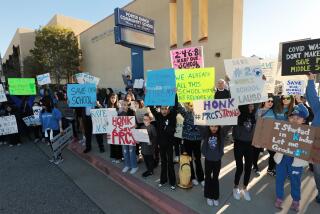Court Might Decide Price of School Land : But, Torrance and District Continue Negotiations for Unused Site
- Share via
TORRANCE — The dispute between school district and city officials over the city’s bid to acquire a closed school site for less than market value may be headed for the courtroom.
In a meeting last week, the two sides presented different interpretations of the Naylor Act, a little-used state law that allows the city to purchase surplus school sites for recreational uses for as little as 25% of the market value.
Both sides expressed optimism that a settlement can be reached, but neither backed away from a possible courtroom confrontation.
“If we don’t reach a compromise, that’s what courts are for,” said City Atty. Stanley Remelmeyer.
“If this matter does go to court, there is no doubt in my mind who would be right,” said Bernard Garen, legal counsel and deputy superintendent of the Torrance Unified School District.
Both sides have agreed to meet again, but no date has been set.
At issue is a restriction in the state law that allows the city to buy only 30% of the district’s total surplus acreage at a reduced rate.
In the city’s initial plan to acquire the Greenwood School at 1520 Greenwood Avenue, only Greenwood and 3.5 acres of Meadow Park School were listed as surplus property. In addition, the city indicated that it was interested in acquiring only the open space area of Greenwood, about 2.57 acres. That would have been about 37% of the total surplus property.
In a revised plan approved two weeks ago by the City Council, the city indicates that it now wants the entire 3.44 acres at Greenwood. However, the plan includes as surplus property four additional school sites, all of which were sold to private developers in the last four years.
Remelmeyer said he interprets surplus school property as any property owned by the school district since the 1981 effective date of the law and not currently used for school purposes. Under this interpretation, the school district would have more than 40 acres of surplus land, making the Greenwood site less than 9% of the total property available.
Additionally, Remelmeyer contends that the entire 3.44 acres is available for the below-market rate because it falls within the 30% limit and it will be used for recreational purposes.
If all of the 3.44 acres falls within the 30% limit, it could mean a saving of nearly $500,000 for the city.
School district officials disagree with the city’s interpretation. So does the state Department of Education.
Henry Heydt, the state’s coordinator of school facilities planning, said there has been little use of the Naylor Act and there are no court decisions to give a clear definition of the requirements.
However, he said, based on the state legislative counsel’s digest of the bill, the city cannot include school sites that have already been sold.
“If (the site) is not currently available for sale, then how can it be the district’s property?” Heydt asked. “It is only what is currently available to the district that can be included as surplus property.”
Heydt also said that only the portion of the surplus land that had been used as a “playground, playing field or other recreational and open-space purposes” qualifies for the below-market rate. About 2.5 acres of the 3.44-acre Greenwood site is recreational space.
City and school district officials also disagree on the full market value of the entire Greenwood site. The city places the value of the land at nearly $1.9 million; the school district says it is worth about $2.2 million.
The city has also asked for a detailed accounting of capital outlay costs incurred by the district as a result of having to transfer students from Greenwood. The state law allows the district to recover those costs in addition to the sale price.
More to Read
Sign up for Essential California
The most important California stories and recommendations in your inbox every morning.
You may occasionally receive promotional content from the Los Angeles Times.













